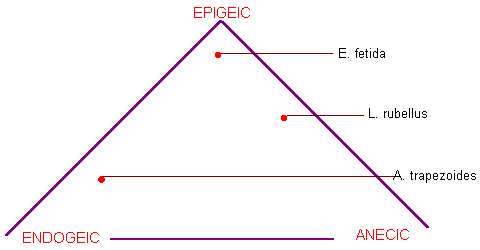
Earthworm Behaviour And Habitat
Earthworms have been classified by a variety of schemes, the most useful being
those based on their behaviour and habitat. The classification of M. Bouche describes
a worm species as occupying a level in the soil and indicates its feeding behaviour.
EPIGEIC (surface dwelling) types live at the surface in freshly decaying plant
or animal residues.
ENDOGEIC types live within the soil and ingest soil to extract nutrition from
degraded organic matter.
ANECIC types burrow deep in the soil but come to the surface at night to forage
for freshly decaying residues.
This classification can be summarised in a triangular graph. A worm species
will have some attributes of all three classes and will fit somewhere within
the triangle and be classed according to how close it lies to one apex.

EARTHWORM SPECIES PASTURE CROP ORCHARD GARDEN COMPOST
Amynthas corticis - - ? + ?
* Allolobophora chlorotica + - - - -
* Aporrectodea caliginosa + ? + + -
* Aporrectodea longa + - - - -
** Aporrectodea rosea + + + + -
** Aporrectodea trapezoides + + + + -
*** Eisenia andrei(red tiger worm) - - - ? +
*** Eisenia fetida(tiger worm) - - - ? +
*** Eiseniella tetraedra ? - ? ? ?
*** Lumbricus castaneus + - ? ? +
* Lumbricus rubellus('true'redworm) ? - ? ? +
* Lumbricus terrestris ? - ? - -
** Microscolex dubius + + + + ?
** Microscolex phosphoreus + + + + -
* Octolasion cyaneum + ? + ? -
*** Perionyx excavatus(Indian blue) - - ? ? +
**** Native earthworms - 200+ species ? ? ? ? ?
* found only in higher rainfall pastures or irrigated crops
** found in pastures and lower rainfall cropping soils
*** found mainly in damp organic wastes, compost
**** found mainly in native, undisturbed soils
Earthworms most commonly associated with land use and waste disposal in
southern Australia.
Pasture = perennial and sown pastures.
Crop = sown cereals, grain-legume & oil-seed crops.
Orchard = horticulture, includes fruit and vegetable and vineyards.
Garden = domestic.
+ = common
- = uncommon or absent
? = suitable habitat, occasionally present.
Buckerfield, J.C. (1994) Appropriate earthworms for agriculture
and vermiculture, Tech. Mem 2/1994, CSIRO Australia,
Division of Soils, Adelaide.
CLASSIFICATION OF EARTHWORMS
The earthworm has been mentioned in history as far back as Aristotle who dubbed the earthworm as "the intestines of the earth", and Cleopatra who had protective laws. Charles Darwin demonstrated that earthworms improve soil conditions and enhance plant productivity.
Scholars of the 18th Century devised a system of classification of plants and animals based on similarities of structure. They also established conventions for naming the classification units based on the Latin and Greek languages. The same basic system exists today and comprises the scientific discipline known as taxonomy, which has strict rules governed by an international body.
In 1758 Linnaeus proposed a system for naming all animal and plant species then known to science. The Linnaeun system is still followed today to provide scientific names.
The basic unit of zoological classification is the 'species', representing a group of animals which can interbreed and produce fertile offspring. All human races can interbreed, even though they have many and varied forms, sizes and colours, and are thus one species known as ....... sapiens. The species name always commences with a small letter.
The unit above (preceding) the species is the 'genus'. The genus always starts with a capital letter. It comprises a group of different species, all sharing a common set of characteristics: such as Homo ... ... thus Homo sapiens. These names are always underlined or italicised in text.
Above the genus is the 'Family', also commencing with a capital letter. There are other higher classifications, but these are the basic ones. The only other classification that you might need to know about is the 'sub-species', which is a classification where two species who have a further constant differing feature can be separated into a sub-species.
To give a practical example amongst worms, many common earthworms belong to the Family Lumbricidae. A common genus in this family is Lumbricus. There are several species of Lumbricus, such as terrestris, the classic 'text book' worm so well known in Europe and North America, and rubellus, which is the common 'red' found under dung in southem Australia. And so we have Lumbricus
terrestris and Lumbricus rubellus.
Another well known worm which belongs to a different genus is Eisenia and a species name is fetida. And so the full name is Eisenia fetida, commonly called the 'tiger worm'. There is a uni-coloured variant, the 'red tigerworm' which is called andrei. It is referred to as Eisenia andrei.
To complete the scientific description the name of the person who first made a scientific description of a particular species (the Author) is placed after the species name, together with the date on which the description was published. Thus our friend the 'uni-coloured tigerworm' is then Eisenia andrei Bouche (1972). lt was Marcel Bouche who first described the variant as an acceptable species in 1972. Once the full name has been cited in the text, this can be abbreviated, e.g. E. andrei.
All very confusing? Why bother, you might ask, with sometimes unpronounceable Latin and Greek names. The answer is that the scientific names are used and understood worldwide, but 'common' or 'local' names often differ from country to country for the same animal or plant, or the same 'common' name is used to describe two different animals. Wormgrowers should be able to identify their species.
|


